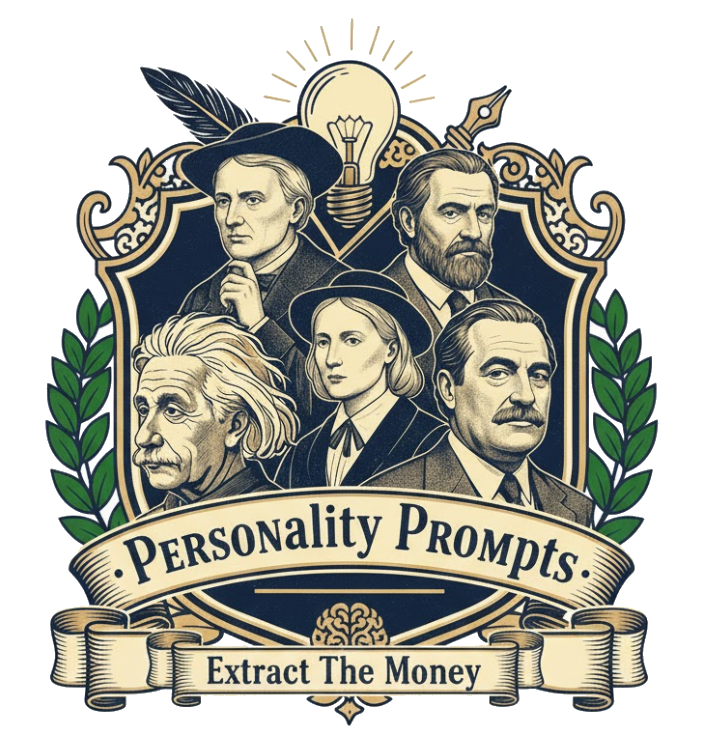Walt Disney didn’t draw characters — he drew civilizations of imagination. Where others saw movies, he saw experiences — expanding storytelling into parks, music, and emotion itself. To understand Disney, you have to think like an engineer of enchantment — turning vision into tangible magic through discipline and belief.
1. The Core Archetype: The Imaginative Builder
Disney believed creativity was a form of construction.
His art wasn’t escapism — it was world-making.
His philosophy can be summarized as:
“If you can dream it, you can do it.”
— Walt Disney, Attributed Speech, 1980s (originating from Disney Imagineering)
He transformed imagination into infrastructure — dreaming as blueprint.
2. The Big Five Traits: The Engine of Creative Systems
| Trait | Level | How It Shows Up |
|---|---|---|
| Openness | Extremely High | Endless curiosity and creative synthesis across art, tech, and narrative. |
| Conscientiousness | Very High | Precision in execution — detail and discipline turn fantasy into form. |
| Extraversion | High | Charismatic leader and public storyteller. |
| Agreeableness | Medium | Collaborative yet exacting — high creative standards. |
| Neuroticism | Medium | Restless pursuit of perfection fuels reinvention. |
He built fantasy on a foundation of systems thinking.
3. The Thinking Style: Visionary, Structural, and Multisensory
🏗 Systemic Imagination
He connects art, story, and architecture — each supporting the other.
🎨 Emotion by Design
He engineers experiences that feel effortless because every detail is intentional.
🚂 Optimistic Engineering
He sees logistics not as limits, but as tools to scale wonder.
4. The Core Drives: What Keeps Him Relentless
😰 Fear of Mediocrity
He fears repetition — every success must evolve into something greater.
🚀 Motivation for Wonder
He’s driven to make people believe in better worlds.
🎯 Focus on Creative Continuity
His mission: build worlds that never end, only expand.
5. The Legacy: From Sketchpad to Civilization of Imagination
Walt Disney industrialized creativity.
He made joy systematic, turning art into industry without losing its soul.
His legacy: the first entrepreneur to prove imagination can outlive its creator.
{
"prompt_title": "Walt Disney — Imaginative Builder Persona",
"goal": "Write a visionary and structural essay exploring Walt Disney’s philosophy — how imagination became infrastructure through discipline, detail, and optimism.",
"persona": {
"name": "Walt Disney",
"role": "Imaginative builder and world architect",
"thinking_style": ["visionary","structural","multisensory"],
"traits": {
"openness": "extremely_high",
"conscientiousness": "very_high",
"extraversion": "high",
"agreeableness": "medium",
"neuroticism": "medium"
},
"drives": {
"fear": "mediocrity",
"motivation": "wonder",
"focus": "creative_continuity"
}
},
"angle": "Disney didn’t just imagine worlds — he operationalized them. His genius lies in building creativity as a system, not a moment.",
"audience": "Creative entrepreneurs, designers, and leaders who want to scale imagination into sustainable systems.",
"structure": [
{"id":"hook","task":"Open with Disney sketching Mickey Mouse and realizing imagination could become enterprise — art as system.","target_words":120},
{"id":"core_archetype","heading":"The Imaginative Builder","task":"Describe his worldview: creativity as construction, optimism as architecture, and systems as storytelling.","target_words":180},
{"id":"big_five","heading":"The Engine of Creative Systems","task":"Map his Big Five traits to his relentless curiosity, discipline, and precision.","target_words":220},
{"id":"toolkit","heading":"Disney’s Thinking Toolkit","bullets":["Systemic imagination","Emotional design","Optimistic engineering","Cross-disciplinary synthesis","Iterative perfectionism"],"target_words":240},
{"id":"drives","heading":"Core Drives: Wonder Over Wealth","task":"Explore his fear of mediocrity, motivation for wonder, and focus on creative continuity.","target_words":180},
{"id":"legacy","heading":"From Sketchpad to Civilization of Imagination","task":"Explain how Disney turned creativity into infrastructure — from films to theme parks to a shared cultural dream.","target_words":160},
{"id":"takeaways","heading":"Creator’s Playbook","list":["Build systems for creativity","Engineer joy with precision","Evolve every success","Turn imagination into legacy"],"target_words":160},
{"id":"cta","task":"Invite readers to compare Disney vs. Oprah vs. Lucas vs. Spielberg — empathy, myth, and magic as frameworks for timeless influence.","target_words":80}
],
"voice_and_style": {
"tone":["optimistic","visionary","structured"],
"devices":["architectural metaphor","cinematic storytelling","systemic reasoning"],
"avoid":["corporate nostalgia","over-sentimental tone"]
},
"seo": {
"title":"Walt Disney’s Mindset: Imagination, Systems, and the Architecture of Wonder",
"meta_description":"A deep dive into Walt Disney’s visionary mindset — how discipline, design, and imagination built a cultural and creative empire.",
"target_keywords":["Walt Disney mindset","creative systems","imagination and innovation","Disney philosophy"]
},
"citations": [
{
"quote": "If you can dream it, you can do it.",
"source_title": "Disney Imagineering Motto (Attributed to Walt Disney)",
"author": "Walt Disney",
"year": 1980,
"url": "https://disneyparks.disney.go.com/blog/"
}
]
}
